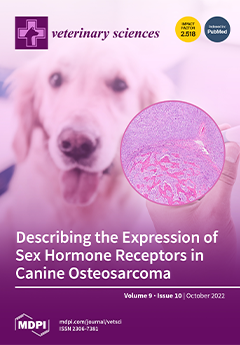Brucellosis is one of the most important bacterial zoonotic diseases worldwide, characterized in domestic animals by long-term reproductive disorders. As known, wild boars (
Sus scrofa) are natural hosts for
Brucella suis biovar 2, in which the infection passes in inapparent form,
[...] Read more.
Brucellosis is one of the most important bacterial zoonotic diseases worldwide, characterized in domestic animals by long-term reproductive disorders. As known, wild boars (
Sus scrofa) are natural hosts for
Brucella suis biovar 2, in which the infection passes in inapparent form, increasing the pathogen transmission risk to domestic pigs, other domestic animals and humans. So far, no studies regarding brucellosis in wild boars in Serbia have been published. During the hunting season 2020/2021, 480 sera of wild boars living in Serbia were collected and tested for the presence of anti-
Brucella antibodies. For the serological survey, the Rose Bengal Test (RBT) and competitive enzyme-linked immunosorbent assay (c-ELISA) were used. Of the 480 sera, 45 sera tested positive, indicating the acquired
Brucella seroprevalence in wild boars of 9.4%. The greatest numbers of
Brucella seropositive animals were detected in the eastern parts of the country and in one of the central districts, i.e., Pomoravski, Branicevski, Borski and Juznobanatski. This study provides the first data regarding brucellosis in the wild boar population in Serbia, revealing the seroprevalence of
Brucella, thus indicating that wild boars as natural hosts and/or vectors of
Brucella likely present a risk for the infection of other animals.
Full article






